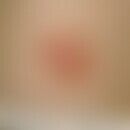Synonym(s)
Hydrocarbon gels; Hydrophobic ointments; Wax Ointment (DAB)
DefinitionThis section has been translated automatically.
Water-free bases that can only absorb small amounts of water. These include:
- Hydrocarbon gels: e.g. Vaselinum album and Vaselinum flavum, paraffins (Paraffinum solidum and microcristallinum), liquid paraffins (Paraffinum subliquidum and perliquidum)
- Lipogels (particularly well tolerated due to their strong skin affinity), in contrast to hydrocarbon gels, must be stabilized with the help of antioxidants (note: vegetable oils contain tocopherols as antioxidants). Examples: vegetable oils or animal fats, synthetic glycerides, waxes (cera alba, cera flava, cera liquida, cetyl palmitate, cetyl alcohol), liquid polyalkylsiloxanes (= silicone oils, e.g. dimethicone).
Pharmacodynamics (Effect)This section has been translated automatically.
Moisture-impermeable covering of treated skin areas with maceration of the stratum corneum and penetration of contained medicinal substances even into deeper skin layers.
You might also be interested in
IncompatibilityThis section has been translated automatically.
Without the addition of emulsifiers, processing in water or aqueous drug solutions is not possible or only possible to a very limited extent, mixing with hydrophilic bases (e.g. hydrogels, O/W emulsions) is also only possible to a limited extent. Peroxides (protection against light, air and heat) can cause oxidative changes in incorporated active ingredients.
Recipe(s)This section has been translated automatically.
PreparationsThis section has been translated automatically.
Examples of ready-to-use preparations: Ash Base Fatty Ointment, Dermatop Base Fatty Ointment, Excipial Almond Oil Ointment, Neribas Fatty Ointment, Kerasal Base Ointment, Topisolon Base Fatty Ointment.




